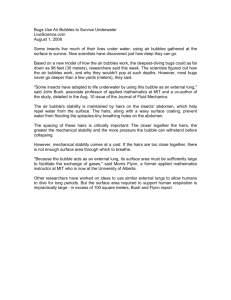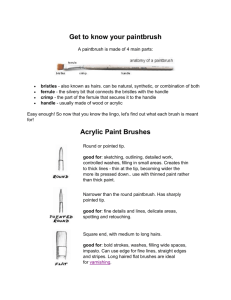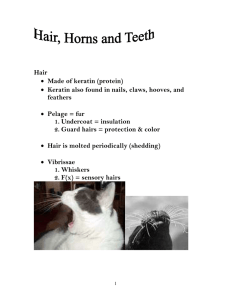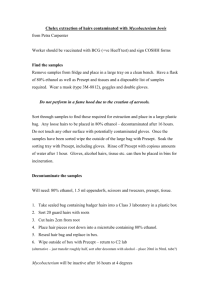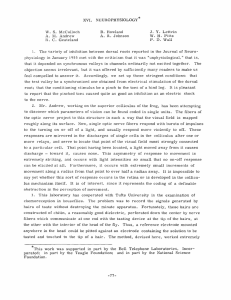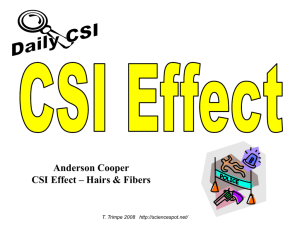1oxfitates M/iineuicanJiuseum Theraphosid Spiders The Urticating Hairs of
advertisement
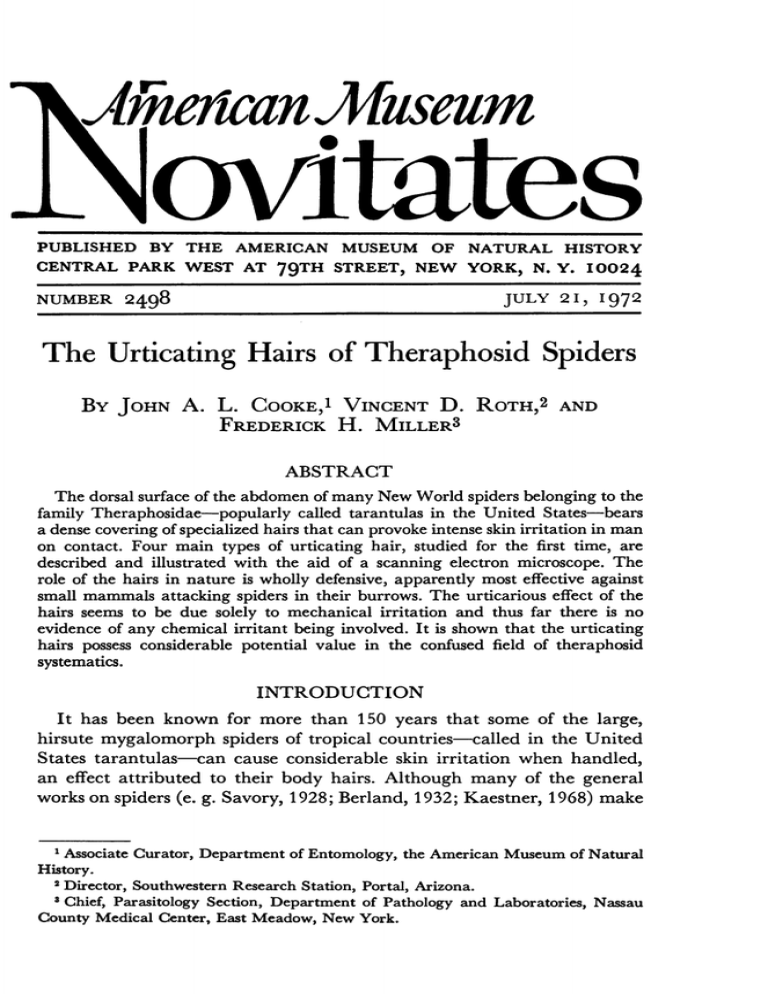
M/iineuican Jiuseum
1oxfitates
PUBLISHED BY THE AMERICAN MUSEUM OF NATURAL HISTORY
CENTRAL PARK WEST AT 79TH STREET, NEW YORK, N. Y. I0024
NUMBER
2498
JULY 2 I, 1972
The Urticating Hairs of Theraphosid Spiders
BY JOHN A. L. COOKE,1 VINCENT D. ROTH,2
FREDERICK H. MILLER3
AND
ABSTRACT
The dorsal surface of the abdomen of many New World spiders belonging to the
family Theraphosidae-popularly called tarantulas in the United States-bears
a dense covering of specialized hairs that can provoke intense skin irritation in man
on contact. Four main types of urticating hair, studied for the first time, are
described and illustrated with the aid of a scanning electron microscope. The
role of the hairs in nature is wholly defensive, apparently most effective against
small mammals attacking spiders in their burrows. The urticarious effect of the
hairs seems to be due solely to mechanical irritation and thus far there is no
evidence of any chemical irritant being involved. It is shown that the urticating
hairs possess considerable potential value in the confused field of theraphosid
systematics.
INTRODUCTION
It has been known for more than 150 years that some of the large,
hirsute mygalomorph spiders of tropical countries-called in the United
States tarantulas-can cause considerable skin irritation when handled,
an effect attributed to their body hairs. Although many of the general
works on spiders (e. g. Savory, 1928; Berland, 1932; Kaestner, 1968) make
I Associate Curator, Department of Entomology, the American Museum of Natural
History.
2 Director, Southwestern Research Station, Portal, Arizona.
3 Chief, Parasitology Section, Department of Pathology and Laboratories, Nassau
County Medical Center, East Meadow, New York.
2
AMERICAN MUSEUM NOVITATES
NO. 2498
brief mention of this phenomenon, the majority of references to it in
the literature may be traced back to the popular accounts given by von
Langsdorff (1812, 1813) and Bates (1863) when describing their travels
in South America. There are, however, a number of corroborative firsthand
reports of urticaria following the handling of spiders (e. g. Vellard, 1936;
Bristowe, 1941; Baerg, 1958) and many arachnologists have personally
described their experiences to us. The fullest published accounts are
probably those of Torres (1921), Gertsch (1949), and Biucherl (1951).
Although these authors established the defensive role of the hairs in
response to attacks by small mammal predators, they gave no indication
of the structure of the hairs and only speculated about the nature of the
effect they produce.
The observations reported in the present paper are the outcome of two
essentially independent investigations, the first of which was initiated
by Roth in 1969, who studied the urticating hairs of several species of
theraphosid spider and recognized four main hair types. He also studied
the effects of the hairs from Aphonopelma species in Arizona on a variety
of local desert animals. By combining these findings with the results of
a second investigation by Cooke and Miller that began toward the end of
1970, we are now able to report on the urticating hairs of more than 40
spider species. The structure of the four main hair types as revealed by
the scanning electron microscope (SEM) is described, and we also consider the manner in which the hairs are used and how they produce their
urticating effect in both man and rodents. Finally we draw attention to
the potential value of urticating hairs in systematic studies of theraphosid
spiders.
MATERIALS AND METHODS
Urticating hairs from representatives of all seven theraphosid subfamilies were gathered from preserved material in the collections of the
American Museum of Natural History and the British Museum (Natural
History). Hairs for experimental purposes came from living spiders collected in the field or lent by colleagues.
Hairs for microscopical examination were collected and preserved in
70 percent ethanol. A sample from each specimen was mounted on slides
in dimethyl hydantoin formaldehyde (DHF) (Cooke, 1970) for reference
and for measuring. Hairs from selected species were prepared for examination under the scanning electron microscope as follows. Hairs collected
from preserved specimens tended to be rather dirty and although an
attempt was made to clean them ultrasonically as suggested by Shear and
Levi (1970) the best results were obtained by cleaning them in lactophenol.
1972
COOKE, ROTH, AND MILLER: URTICATING HAIRS
3
After mounting on metal specimen stubs, using aluminum paint as cement,
the cleaned hairs were air dried and then coated with approximately
200 X. of gold in a vacuum evaporator. Examination was at 20 kv. with
a Cambridge Stereoscan Mark II Scanning Electron Microscope.
The effects of the hairs on man were investigated by biopsy following
application to the skin of the upper arm. The effects on small mammals
were studied in laboratory white mice, which were subsequently killed
and serially sectioned for histological examination. Surface view SEM
pictures of hairs penetrating the skin were obtained from newborn mice,
which were impregnated with epon after fixation. Subsequently the surface epon was washed off with propylene oxide, leaving the skin still
supported and relatively free from distortion during the evaporation
process.
The reactions of potential predators to Aphonopelma hairs were tested
under artificial conditions using well-fed captive vertebrates with the
spiders outside their burrows.
Measurements used in compiling tables 2, 3, and 4 were taken from
camera lucida drawings of material mounted on slides. Between five and
10 hairs of each species were measured to an accuracy of 4±0.005 mm.
Authors' names of spider species mentioned in the body of the text will
be found in table 1, which lists the species examined in systematic order.
ACKNOWLEDGMENTS
We express our gratitude to the many colleagues who have recounted
their experiences with theraphosids to us and to those who have provided
us with living specimens. In particular we thank Drs. W. J. Gertsch and
H. W. Levi, Miss Alice Gray, and Mr. A. L. Bordes. Special thanks are
due to Corinne Chubb, whose generous hospitality enabled Cooke to
collect and observe theraphosids in the British Virgin Islands. We are
grateful to the Southwest Traildust Zoo, Bisbee, Arizona, and the Sonora
Desert Museum, Tucson, Arizona, for the loan of many of the vertebrate
predators used in the experiments. We also thank Prof. G. F. Knowlton
for information on spiders as the prey of lizards, Dr. J. L. Duffy for
examining biopsy specimens, and Prof. R. E. Wheeler for allowing us to
quote from his notes.
ABDOMINAL HAIRS
The integument of spiders is richly endowed with hairs. These are of
many different types but are, for the most part, of unknown function.
For example, the dorsal integument of the Arizona theraphosid Aphonopelma chalcodes carries at least four distinct types of hair. The basic pelage
4
AMERICAN MUSEUM NOVITATES
NO. 2498
consists of strongly pilose hairs approximately 0.5 mm. in length at a
density of 300-400 per square mm. Interspersed with these are stouter,
more finely pilose hairs slightly over 1 mm. in length and present at a
density of roughly 100 per square mm. Projecting above the basic pelage
and conspicuous because of their brownish orange color are finely pilose
"guard" hairs about 4 mm. at a density of two or three per square mm.
Hairs of the fourth type are short (0.3 mm.), sharply pointed and barbed,
and are present in enormous numbers- 10,000 to 12,000 per square mm.
These are the urticating hairs, which form a characteristic dorsal patch
on the rear part of the abdomen. Contrary to von Langsdorff's (1813)
statement, the urticating hairs do not cover the whole body of the spider.
URTICATING HAIRS
Urticating hairs appear to be restricted to New World representatives
of the theraphosid subfamilies Ischnocolinae, Grammostolinae, Theraphosinae, and Aviculariinae, but do not occur on every species. So far as
we can determine there is nothing to suggest that urticating hairs are
found outside the New World and certainly none was present on the
extensive material we examined. The report attributed to the explorer
Henry Stanley [quoted by Schwarz (1890) on the basis of a newspaper
article appearing in "Das Ausland"] may be dismissed as journalistic
embellishment. Distant (1898), making reference to Bates's (1863) experiences in Brazil, attributed the near death of a cat in South Africa to the
effects of urticating hairs on a specimen of Harpactira gigas Pocock, which
it had eaten. Nothing in Distant's account, however, indicates that
urticating hairs were really involved and in view of our failure to find
urticating hairs on any African spiders, including members of the genus
Harpactira, we believe this report should be discounted.
According to Biicherl (1951), urticating hairs first appear on Grammostola in the third instar, the stage following the first light covering of hairs
on the body, when, it is believed, the young spiders leave the parental
burrow to lead independent lives. In many young spiders the urticating
hairs form a conspicuous dark, velvety spot (fig. 1), which may persist
throughout life in some species. In others, however, the edges of the hair
field become increasingly indistinct as the spiders age and the body
becomes more hirsute. In Avicularia surinamensis the spiderlings leaving the
cocoon-presumably in the third instar-have a limited number of Type
II urticating hairs (see below) only a little smaller than those occurring
on the adults, lying flush with the abdominal surface.
In the majority of spiders molting ceases at maturity. However female
mygalomorph spiders (and a few other long-lived forms such as female
1972
COOKE, ROTH, AND MILLER: URTICATING HAIRS
5
4~~~~4
FIG. 1. Young specimen (third or fourth instar) of Aphonopelma sp., showing
conspicuous patch of Type I urticating hairs on posterior dorsum of abdomen.
Filistatidae) continue to molt approximately every year throughout life,
acquiring at. each molt a fresh vestment of hairs (fig. 2). Theraphosids
that have not molted for some months in many cases present a rather
moth-eaten appearance (fig. 3) and individuals that have used their
urticating hairs extensively may even display bald patches corresponding
to the size of the hair field.
6
NO. 2498
AMERICAN MUSEUM NOVITATES
TABLE 1
DISTRIBUTION OF URTICATING HAIR TYPES
Species
ISCHNOCOLINAE
Cyrtopholis bartholomaei (Latreille)
C. jamaicola Strand
C. longistylus Kraus
Hapalopus pentaloris (Simon)
Metriopelmafamiliare (Simon)
GRAMMOSTOLINAE
Aphonopelma chalcodes Chamberlin
A. eutylenum Chamberlin
A. moderatum (Chamberlin and
Locality
Sex
Antigua
Haiti
El Salvador ci
9
Mexico
Venezuela
Arizona
California
Texas
9
I
Hair Type
II III IV None
-t
+
-d-
Cambridge
Citharacanthus spinicrus (Latreille)
Grammostola sp.
G. actaeon (Pocock)
G. iheringi (Keyserling)
Paraphysa manicata Simon
Pterinopelma velutinum MelloLeitao
Plesiopelm9 sp.
Sphaerobothria hoffmani Karsch
THERAPHOSINAE
Acanthoscurria atrox Vellard
A. rhodothele Mello-Leitao
A. sternalis Pocock
A. violacea Mello-Leitao
Lasiodora klugi (C. L. Koch)
Pamphobeteus tetracanthus
Mello-Leitao
,o
+
-
-
_-
+
9
9
9
+
c,
a,
9
+
+
+
9Qca, +
ci
ci
9,
+
+
+
+
+
9
c
+
-
+
Cuba
Uruguay
Brazil
Brazil
Chile
Brazil
a"
+
Brazil
Costa Rica
+a
9
9, ci +
Brazil
Brazil
Brazil
Brazil
Brazil
Brazil
a"
9
9
9
9
0d
od
9
_
+--
Ivie)
A. reversum Chamberlin
California
A. seemanni (F. 0. PickardGuatemala
Cambridge)
Delopelma helluo (Simon)
Mexico
D. melania Chamberlin and Ivie Utah
Dugesiella hentzi (Girard)
Texas
Texas
D. wacona Chamberlin
D. echina Chamberlin
New Mexico
Mexico
Brachypelma emilia (White)
B. smithi (F. 0. PickardMexico
Cambridge)
Eurypelma caniceps Simon
Mexico
E. mesomelas 0. PickardMexico
-
+
+
+
+
+
-
-
1972
7
COOKE, ROTH, AND MILLER: URTICATING HAIRS
TABLE 1-(Continued)
Species
Phormictopus cancerides (Latreille)
Sericopelma rubronitens (Ausserer)
AVICULARIINAE
Avicularia avicularia (Linnaeus)b
A. surinamensis Strand
A. lacta (C. L. Koch)
A. velutina Simon
Psalmopeus reduncus (Karsch)
Tapinauchenius plumipes
(C. L. Koch)
EUMENOPHORIINAE
Phoneyusa bidentata Pocock
Ephebopus murinus (Walckenaer)
SELENOCOSMIINAE
Ceratogyrus darlingi Pocock
Selenocosmia sp.
ORNITHOCTONINAE
Ornithoctonus andersoni Pocock
Locality
West Indies
Panama
Sex
9
9
Hair Type
II III IV None
I
+
+
+
Trinidad
Guyana and c
-
Trinidad
Puerto Rico
+
Trinidad
9Costa Rica 9
+
9
Guyana
Congo
Guyana
9, c-
India
-
9
-
-
-
-
-
-
-
-
-
-
+
-
-
+
+
+
9
Central
Africa
New Guinea 9,
+
+
-
-
-
+
-
+
+
Hairs of two distinct sizes present.
bConsiderable confusion surrounds the identity of these Avicularia species and the
specific names must be regarded as tentative.
a
We recognize in the Theraphosidae four main types of urticating hair,
and their distribution among the identified species examined is summarized
in table 1. A feature common to all four types, and one that distinguishes
urticating hairs immediately from other types of abdominal hair, is the
mode of attachment. Whereas other abdominal hairs arise from characteristic cups or sockets (figs. 22-24), the urticating hairs are attached to
the cuticle of the spider by a smooth stalk approximately 0.10 mm.
in length.
DESCRIPTION OF URTICATING HAIR TYPES: Type I (figs. 4-8, 29): Approximate length 0.2-0.6 mm. These hairs are characterized by a group of
barbs at the basal (i. e. functionally rear) end that are reversed in direction.
These reversed barbs may be separated from the main set of barbs by a
length of bare shaft but not always so. The shaft itself is bent or kinked
and the main barbs, which form a single or double row, are arranged
helically. In front of the main barbs, the shaft tapers to a sharp point and
carries minute backward-pointing denticles.
Type II (figs. 9-12, 20): Approximate length 0.5-1.5 mm. These hairs
t +Rs*->jS;iR
X,
t-{ -
s +
'_4zzi-
--
4
;
,
-
-
t _.
AM-
_>-
-.A
_..
:
./ _::
XA'
;-
FIG. 2. Brachypelma smithi (F. 0. Pickard-Cambridge), soon after molting. A.
Frontal view. B. Dorsolateral view of abdomen, showing pelage largely intact.
Guard hairs are conspicuous and several dislodged Type III urticating hairs are
also visible. The latter are pale in color, much smaller than guard hairs, and tend
to clump together.
8
A'
FIG. 3. Brachypelma smithi (F. 0. Pickard-Cambridge), toward end of intermolt
period; as urticating hairs are discharged, hair field becomes rather barren. A.
General view of abdomen from behind. B. Detail of the hair field, showing regions
of bare cuticle and many loose Type III urticating hairs.
9
AMERICAN MUSEUM NOVITATES
10
NO. 2498
TABLE 2
RELATIVE PROPORTIONS IN TYPE I URTICATING HAIRS
Mean Standard a/la Standard
Sex Length Deviation Mean Deviation
Species
(in mm.)
ISCHNOCOLINAE
Cyrtopholis jamaicola
longistylus Kraus
Strand
C.
e
0.21
e
0.50
c'
0.43
0.013
0.018
0.20
0.19
0.015
0.007
0.016
0.009
0.013
0.031
0.015
0.027
0.009
0.010
0.011
0.021
0.047
0.052
0.015
0.020
0.044
0.009
0.027
0.42
0.43
0.44
0.36
0.19
0.34
0.40
0.29
0.20
0.44
0.25
0.23
0.29
0.19
0.21
0.22
0.25
0.017
0.014
0.010
0.022
0.011
0.013
0.020
0.015
0.018
0.025
0.050
0.019
0.015
0.007
0.019
0.034
0.011
0.005
0.13
0.12
0.17
0.22
0.27
0.39
0.017
0.000
0.016
0.030
0.011
0.030
GRAMMOSTOLINAE
Aphonopelma
A.
eutylenum
chalcodes Chamberlin
Chamberlin
0.40
A. moderatum (Chamberlin and Ivie)
A. reversum Chamberlin
A. seemanni (F. 0. Pickard-Cambridge)
Delopelma helluo (Simon)
0.46
0.35
0.40
0.27
D. melania Chamberlin and Ivie
0.27
Dugesiella hentzi (Girard)
D. wacona Chamberlin
9
D. echina Chamberlin
Brachypelma emilia
B. smithi
(F.
0.
0.44
(White)
0.36
Pickard-Cambridge)
Eurypelma caniceps Simon
Citharacanthus spinicrus (Latreille)
Pterinopelma vellutinum Mello-Leitao
Plesiopelma sp.
Sphaerobothria hofmani
e
9
ei
9
9
Karsch
0.38
0.41
0.28
0.50
0.28
0.47
THERAPHOSINAE
Acanthoscurria rhodothele Mello-Leitao
A. sternalis Pocock
A. violacea Mello-Leitao
9
9
c'
Lasiodora klugi (C. L. Koch)
Pamphobeteus tetracanthus Mello-Leitao
Sericopelma rubronitens (Ausserer)
a
0.34
0.28
0.45
0.42
0.22
0.44
0.57
0.18
See figure 29.
_e_fi..~~~_-noFIG. 4. Type I urticating hair, in silhouette.
._ft%
0.019
0.021
0.032
0.005
0.011
1972
11
COOKE, ROTH, AND MILLER: URTICATING HAIRS
TABLE 3
RELATVE PROPORTONS IN TYPE I URTICATING HAIRS
Species
ISCHNOCOLINAE
Cyrtopholisjamaicola Strand
C. longistylus Kraus
GRAMMOSTOLINAE
Aphonopelma chalcodes Chamberlin
A. eutylenum Chamberlin
A. moderatum (Chamberlin and Ivie)
A. reversum Chamberlin
A. seemanni (F. 0. Pickard-Cambridge)
Delopelma helluo (Simon)
D. melania Chamberlin and Ivie
Dugesiella hentzi (Girard)
D. wacona Chamberlin
D. echina Chamberlin
Brachypelma emilia (White)
B. smithi (F. 0. Pickard-Cambridge)
Eurypelma caniceps Simon
Citharacanthus spinicrus (Latreille)
Pterinopelma vellutinum Mello-Leitao
Plesiopelma sp.
Sphaerobothria hofmani Karsch
THERAPHOSINAE
Acanthoscurria rhodothele Mello-Leitao
A. sternalis Pocock
A. violacea Mello-Leitao
Lasiodora klugi (C. L. Koch)
Pamphobeteus tetracanthus Mello-Leitao
Sericopelma rubronitens (Ausserer)
b/la Standard c/la Standard
Sex Mean Deviation Mean Deviation
9
9
9
0.14
0.21
0.029
0.04
0.18
0.15
0.019
0.015
0.10
0.11
0.10
0.11
0.19
0.12
0.09
0.12
0.19
0.09
0.15
0.18
0.15
0.20
0.17
0.16
0.18
0.012
0.013
0.022
0.008
0.029
0.017
0.020
0.022
0.011
0.042
0.054
0.020
0.030
0.10
0.12
0.10
0.13
0.19
0.16
0.13
0.17
0.23
0.11
0.17
0.17
0.15
0.17
0.12
0.18
0.14
0.012
0.015
0.011
0.029
0.008
0.025
0.016
0.012
0.016
0.023
0.032
0.030
0.015
0.014
0.012
0.017
0.014
0.24
0.33
0.17
0.26
0.16
0.10
0.026
0.015
0.041
0.045
0.017
0.031
0.18
0.14
0.20
0.12
0.12
0.17
0.020
0.037
0.019
0.019
0.032
0.029
0.019
0.019
0.012
0.030
aSee figure 29.
are found only on certain members of the subfamily Aviculariinae, particularly the genus Avicularia. They take the form of a straight, sometimes
rather cigar-like shaft, pointed at both ends. The barbs are small and in
Avicularia surinamensis (fig. 12) consist only of tiny spatulate denticles
restricted to the basal end. In A. avicularia (fig. 11), however, the barbs
are rather larger and cover all but the distal portion of the shaft.
The most remarkable feature of Type II hairs, and one that sets them
quite apart from other spider hairs, is the direction in which the barbs
lie. In the other three hair types the barbs are directed in such a way that
the penetrating tip of the hair is upward, away from the body, i.e. distal.
12
AMERICAN MUSEUM NOVITATES
NO. 2498
FIG. 5. Lasiodora klugi (C. L. Koch). Type I urticating hair, showing main
barbs lying in double row distally and small denticles that extend along the shaft
from penetrating tip. X2100.
In contrast the Type II hairs lie with the penetrating tip downward
(figs. 20, 21). The point at which the hair is attached to its supporting
stalk, just distal to the tip, presents after the hair is shed, the appearance
1972
COOKE, ROTH, AND MILLER: URTICATING HAIRS
13
/
FIG. 6. Lasiodora klugi (C. L. Koch). Detail of paired distal main barbs of
Type I urticating hair. X5400.
of a small pore, (visible in fig. 12). By analogy with the hairs of Lepidoptera, we suspected that this pore might lead into the lumen of the
shaft and that Type II hairs could possess a chemical irritant. The small
size of the barbs and the curious orientation of the hairs also lent weight
14
AMERICAN MUSEUM NOVITATES
NO. 2498
Fig. 7. Lasiodora klugi (C. L. Koch). Type I urticating hair. Detail of surface
sculpturing at junction between the main barbs and shaft. X 13,000.
to this idea. However, sectioning the hairs revealed that the lumen ended
some distance from the pore and was not in connection with the outside,
making it unlikely that any chemical irritants are actually involved.
Type III (figs. 13-16): Approximate length 0.3-1.2 mm. These long,
1972
COOKE, ROTH, AND MILLER: URTICATING HAIRS
15
FIG. 8. Lasiodora klugi (C. L. Koch).
Reversed barbs at basal end of Type I
urticating hairs. X 780.
thin straight-shafted hairs have a fine point and barbs along at least
one-half the length. There is considerable variation not only in length but
also in the size and density of the barbs among hairs of this type.
Type IV (figs. 17-18): Approximate length 0.06-0.2 mm. These very
small dartlike hairs are chiefly characterized by their size and appear to
be typical of the genus Grammostola. Although the shaft may be either
straight or bent, they resemble one another in having the barbs restricted
to the posterior end. Nothing is known of the urticating effects of Type IV
hairs, but it is possible that they are responsible for the effects reported
by Biucherl (1951) in rats and mice (see below).
In those spiders possessing more than one kind of urticating hair it
appears that, in some species at least, the different types are segregated
into distinct areas of the hair field. However, it is not clear whether all
species have the hairs so arranged or whether in some the hair types are
mixed randomly over the entire field. Examination of the abdomen under
the binocular microscope presents a confused picture because the hairs
are so densely packed. However, if the abdominal wall is sectioned (fig. 19)
the arrangement of the hairs on their supporting stalks is clearly visible
and the question of the distribution of different hair types will probably
be resolved by a program of serial sectioning.
FIG. 9. Type II urticating hair, in silhouette.
16
NO. 2498
AMERICAN MUSEUM NOVITATES
VARIATION
IN
TABLE 4
TYPE III URTICATING HAIRS
Mean
Species
ISCHNOCOLINAE
Cyrtopholis bartholomaei (Latreille)
Hapalopus pentaloris (Simon)
GRAMMOSTOLINAE
Brachypelma emilia (White)
B. smithi (F. 0. Pickard-Cambridge)
Eurypelma mesomelas 0. PickardCambridge
Citharacanthus spinicrus (Latreille)
Grammostola sp.
G. acteon (Pocock)
G. iheringi (Keyserling)
A
Paraphysa manicata Simon
B
Pterinopelma velutinum Mello-Leitao
Standard a/la Standard
Sex Length Deviation Mean Deviation
(in mm.)
0.47
0.36
0.031
0.008
0.30
b
0.014
0.76
1.51
1.04
0.060
0.040
0.037
0.36
0.19
0.28
0.025
0.029
0.028
0.015
0.037
0.084
0.020
0.025
0.049
0.036
0.33
0.028
0.15
0.017
9
0.66
0.36
1.08
1.21
0.62
0.44
0.64
0.32
0.022
ci'
9
9
c'
9
0.84
0.82
0.74
0.65
0.46
0.004
0.018
0.028
0.049
0.017
0.27
0.017
0.30
0.030
e
9
e
9
ci
c'
ci
ci
ci
9
9
THERAPHOSINAE
Acanthoscurria atrox Vellard
A. rhodothele Mello-Leitao
A. sternalis Pocock
Lasiodora klugi (C. L. Koch)
Sericopelma rubronitens (Ausserer)
See figure 29.
species, especially those with small barbs, it was not possible to measure
the distance "a" with accuracy so the ratio a/l is omitted.
a
b In some
When hairs are removed from spiders by scraping, the supporting
stalks are often broken off from the integument but remain attached to
the hairs. This happens particularly with Type II hairs and helps confirm
their somewhat unexpected orientation with the tip down, as evidenced
by the direction of the barbs (figs. 20, 21).
By examining areas from which the hairs have been shed, it is possible
to calculate hair density by counting the basal stalks. A series of such
counts on Aphonopelma chalcodes gave a density of 9800-11,400 Type I hairs
per square mm. over most of the area, but toward the edges of the hair
field, particularly ventrally where the integument is much folded, the
numbers drop off somewhat. Thus a medium-sized spider would have
over one million hairs to shed during each intermolt period. In Avicularia
the number of Type II hairs is substantially less. Under the SEM, patches
1972
COOKE, ROTH, AND MILLER: URTICATING HAIRS
17
FIG. 10. Avicularia surinamensis Strand. Type II urticating hair. X205.
of integument from which the hairs have been removed take on a curiously
desolate appearance (figs. 22, 23). Among the forest of stalks may be seen
not only the insertion sockets of the ordinary hairs (fig. 24) but hitherto
unknown structures, presumably sensilla, that resemble small baskets of
eggs (fig. 25). The function of these sensilla is uncertain, but it is possible
that they may monitor the turgidity of the abdominal wall.
DEFENSIVE BEHAVIOR
The response of theraphosid spiders to attack or the threat of attack is
subject to both specific and individual variation. Among species that lack
urticating hairs the spiders tend to turn rapidly toward the stimulus and
18
AMERICAN MUSEUM NOVITATES
NO. 2498
Fig. 11. Avicularia avicularia (Linnaeus). Type II urticating hair. A. Smooth
distal section. X510. B. Barbed midsection. X510. C. Penetrating basal tip. X510.
D. Detail of midsection barbs. X2550.
assume an aggressive stance with the fangs displayed. Thus in the African
genera Citharischius Pocock and Pterinochilus Pocock, for example, even a
slight disturbance causes the spider to raise the body almost vertical with
the anterior legs stretched out, and to lunge forward repeatedly. The fangs,
1972
COOKE, ROTH, AND MILLER: URTICATING HAIRS
19
FIG. 12. Avicularia surinamensis Strand. Basal tip of Type II urticating hair.
Note depression marking point at which supporting stalk was inserted. X 2400.
which are surrounded by bright red hairs, are open, and stridulating
organs lying between the chelicerae and the maxillae emit a loud hissing
sound. Among New World spiders such aggressive behavior is less common.
Except when attacked by Pepsis wasps, when they often assume a defensive
stance at or near the entrance to their burrow (Cazier and Mortenson,
20
AMERICAN MUSEUM NOVITATES
NO. 2498
FIG. 13. Type III urticating hair, in silhouette.
FIG. 14. Acanthoscurria rhodothele Mello-Leitao. Midsection of Type III urticating hair, showing massive, well-spaced barbs. X540.
1972
COOKE, ROTH, AND MILLER: URTICATING HAIRS
21
FIG. 15. Grammostola acteon (Pocock). Midsection of Type III urticating hair,
showing form of barbs. X2400.
1964), American theraphosids slowly retreat from potential predators
often laying down an entangling snare of silk at the same time. Usually
it is only as a last resort when approached from the front or cornered that
spiders such as Aphonopelma will use their fangs. The most typical defensive
reaction, particularly if attacked from behind, is hair-flicking. The thresh-
22
AMERICAN MUSEUM NOVITATES
NO. 2498
FIG. 16. Brachypelma smithi (F. 0. Pickard-Cambridge). Midsection of Type III
urticating hair, showing extremely long barbs. X2100.
old for this release of urticating hairs varies widely not only between
species but also between individuals.
The hairs are dislodged from their supporting stalks by rapid vibrations
of one or both of the hind legs, which are lifted onto the dorsum of the
abdomen. It appears that the ventral metatarsal spines play an important
FIG. 17. Type IV urticating hair, in silhouette.
FIG. 18. Mosaic of Type IV urticating hair from unidentified theraphosid
from Chile. X1850.
*+$; -~lin.
AMERICAN MUSEUM NOVITATES
24
'Ais4.lJ&Z,WlA, I
*
t
\}7|/
P ~)//~4:;i
NO. 2498
FIG. 19. AphonopelmachalcodesChamberSection through dorsal abdominal wall,
showing alignment of dense layer of Type I
urticating hairs on supporting stalks. X 86.
role in combing off the hairs, although no comparative study of these
structures has yet been made between species possessing urticating hairs
and those that do not.
It is doubtful whether the urticating hairs provide any protection
against such insect parasites as acrocerid flies or pompilid wasps, and
indeed attacks by pompilids, although quite often observed (e.g. Williams,
1956; Cazier and Mortenson, 1964) have never been reported to induce
hair flicking. Aphonopelma sometimes releases hairs half-heartedly if surrounded by harvester ants (Pogonomyrmex sp.) in experimental conditions
but this is probably a generalized response indicating irritability and does
not appear to have the least effect on the ants. Thus the role of the spider
hairs contrasts markedly with that of the highly specialized hastate hairs
FIG. 20. Diagram of Type II urticating hair to
show way in which supporting stalk is attached.
1972
COOKE, ROTH, AND MILLER: URTICATING HAIRS
1-mmmm
A
OWNkit'
25
Aolkw,
-
-
1!11'1
FIG. 21. Distal tip of Type II urticating hair from Avicularia surinamensis Strand,
showing supporting stalk still attached. X2400.
of dermestid beetle larvae (Nutting and Spangler, 1969) whose prime role
is defense against arthropod predators. The dermestid hairs function by
entangling their arthropod victims and have no immediate effect against
vertebrate predators. However, it should be added that many people
suffer quite severe allergic reactions to contact with the accumulations of
hastate hairs associated with Dermestes infestations.
Little is known of the natural predators of theraphosid spiders, which
are seldom recorded from the stomach contents of birds and mammals
and never from reptiles or amphibia. It is possible, of course, that the
absence of theraphosids from the known diet of snakes and lizards reflects
the effectiveness of the defense system of the spider, but as yet we have no
data on the reactions of these animals to theraphosid urticating hairs.
26
AMERICAN MUSEUM NOVITATES
NO. 2498
FIG. 22. Aphonopelma chalcodes Chamberlin. Dorsal abdominal surface showing
stalks that supported urticating hairs and insertion sockets of other types of abdominal hairs. Large socket of a long guard hair is visible near center of picture. X210.
Theraphosids are cryptic animals and seldom leave their burrows except
in the mating season, when adult males may sometimes be found in quite
large numbers at dusk. Despite their crepuscular activity, they are ap-
1972
COOKE, ROTH, AND MILLER: URTICATING HAIRS
27
FIG. 23. Aphonopelma chalcodes Chamberlin. Dorsal abdominal surface, showing
supporting stalks in area where Type I urticating hairs have been discharged. Also
visible are insertion sockets of two of the hairs that make up basic abdominal
pelage. X1200.
parently not normally preyed upon by the insectivorous owls (Bent, 1938;
Ligon, 1968; Ross, 1969) even though the latter do eat Araneomorph
spiders, scorpions, and centipedes. However, Ohlendorf (1971) cited a
28
AMERICAN MUSEUM NOVITATES
NO. 2498
FIG. 24. Aphonopelma chalcodes Chamberlin. Insertion socket of abdominal guard
hair, surrounded by supporting stalks of Type I urticating hairs. X 950.
Western Horned Owl [Bubo virginianus (Gmelin)] in Texas as having fed
upon Dugesiella. Similarly theraphosids are not recorded among the prey
of the roadrunner [Geococcyx californianus (Lesson)] (Bryant, 1916; McAtee,
1931), which is an omnivorous predator. The record quoted by Sutton
(1940) clearly refers to a lycosid spider and not to a theraphosid. Out of
more than 11,000 coyote (Canis latrans Say) stomachs and scats examined
(Sperry, 1941; Ferrel, Leach, and Tillotson, 1953; Korschgen, 1957) only
three contained theraphosid remains. Korschgen (1957) also found one
specimen among 352 stomachs of the Gray Fox [Urocyon cinereoargenteus
(Schreber)] in Missouri, but he found none in the stomachs of Red Fox
(Vulpes vulpes Linnaeus) in Kansas. Cutler (1958) found none in the food
of the Swift Fox [Vulpes velox (Say)] in northern Texas and Stains (1956)
found none in raccoon [Procyon lotor (Linnaeus)] scats in Kansas. The only
published accounts of theraphosids defending themselves against vertebrates are those of Biicherl (1951) and Torres (1921). Biucherl described
how rats and mice provoke the release of urticating hairs from Grammostola
1972
COOKE, ROTH, AND MILLER: URTICATING HAIRS
it.
Y
t
--m"4
;*q
Al
29
PIA
.4
1%
t
A
* '$
itW
4p
~
FIG. 25. Aphonopelma chalcodes Chamberlin. Surface view of abdominal structure
of unknown function, presumed to be a sense organ. X 1200.
and Lasiodora. The rodents are immediately affected and show increasing
discomfort until some two hours later the mucosa of the respiratory tract
is so inflamed that they may die from asphyxia. In a later work Biucherl
(1962) stated that the spiders make use of the hairs to drive rodents from
NO. 2498
AMERICAN MUSEUM NOVITATES
30
REACTION
OF
TABLE 5
CAGED MAMMALS TO EDIBLE GRASSHOPPERS
Species
Coyote, Canis latrans Say
Bobcat, Felis rufus (Schreber)
Moutain Lion, Felis concolor
Linnaeus
Javelina, Tayassu tajacu
(Linnaeus)
Striped Skunk, Mephitis
mephitis (Schreber)
Hooded Skunk, Mephitis
macroura Lichtenstein
Kit Fox, Vulpes macrotis
Merriam
Raccoon, Procyon lotor
(Linnaeus)
Coati Mundi, N'asua narica
(Linnaeus)
Badger, Taxidea taxus
(Schreber)
Ring-tailed Cat, Bassariscus
astatus (Lichtenstein)
Grasshopper Mouse, Onychomys
torridus (Coues)
Domestic Dog, Canisfamiliaris
Linnaeus
Individual
Test Animals
AND SPIDERS
Reactiona to:
Grasshopper
Aphonopelma sp.
2
2
2
A and B
A
A
2
2
2
A
B
A and B
C
A and B
3, 4, 5
2
2
4, 5
4
2
4
A and B
4
3b
A
B and C
A-F
4
3
A
B
A
B
A and B
C and D
A
2
3, 1
3, Ob
4, 6
3,
6
6
4, 6
4, 6
4, 6
4, 6
3
6
6
Ob
3, Ob
3. 5
3, Ob
4, 6
3,
Ob
3, 4b
a Reactions are rated as follows: 0, retreat; 1, fear; 2, indifference; 3, curiosity; 4,
maul and sometimes kill; 5, eats daintly; 6, eats voraciously.
b Tarantula gave hair-flicking response.
their burrows, which the spiders then take over. Torres, working with
spiders doubtfully attributed to the genus Theraphosa, observed symptoms
of distress in mice and birds but clearly not so extreme as those reported
by Biicherl. In addition, Baerg (1938) attributed the death of white rats
under experimental conditions to the hairs of Brachypelma emilia.
In order to test further the defensive value of urticating hairs to spiders
a number of potential predators were presented with adult males of an
undescribed Aphonopelma species from southeastern Arizona. The tests
were artificial in that the spiders were not within their burrows and the
predators were well-fed captive animals lent by local zoos. In order to
1972
COOKE, ROTH, AND MILLER: URTICATING HAIRS
31
test the willingness of the predators to feed each was first offered an edible
grasshopper. The results of these tests, each with a different animal, are
summarized in table 5. The dog and foxes did not appear to be affected by
the hairs and one fox ate a spider without any apparent irritation. The
badger, raccoons, hooded skunks, and ring-tailed cat backed off immediately after the spider started hair-flicking and except for the hooded
skunks, all showed discomfort with eye-blinking and mouth-licking. The
coati mundi attacked so rapidly that it did not give the spider time to
discharge hairs. Coati mundi are voracious feeders that even eat lubber
grasshoppers [Taeniopoda eques (Burmeister)] which are normally rejected
by other animals.
The grasshopper mice belonging to the genus Onychomys Baird are
important predators of invertebrates and readily attacked the spiders
offered. However, the latter proved to be formidable opponents. Although
two spiders were killed in four tests, the mice all appeared to be affected
by hairs in their eyes. In two cases it was interesting to note that the mice
ate the spider abdomen from beneath, leaving the area of urticating hair
intact. Several exotic mammals, including a stump-tailed macaque
(Macaca speciosa Cuvier), three squirrel monkeys [Saimiri sciureus (Linnaeus) ]
and two tayras [Eira barbara (Linnaeus) ] were frightened by spiders and
would not attack even though they fed ravenously on grasshoppers.
It should be noted that members of the genus Aphonopelma have only
Type I hairs, which produce almost no urticaria in man (see below).
URTICATING HAIR FUNCTION
What slight attention the urticating hairs of spiders have attracted in
the past has, to a large extent, been due to their effects on man, and their
true defensive role in nature has not really been studied.
A large proportion of the New World theraphosids are comparatively
docile and may be handled without difficulty or danger. This is particularly true of the species occurring in the United States. However, even a
spider that does not object to being handled, may, if hurt or agitated,
throw off hairs. Most people who handle theraphosids are familiar with
the urtication that can result. It can range from a mild, short-lived pricking sensation to intense discomfort, with extensive inflammation that
may persist intermittently for several weeks. It appears that Type I hairs
have little effect on man for we have never experienced any marked discomfort when handling spiders possessing only these hairs. Moreover, we
have applied Type I hairs to various sensitive areas such as lips and eyelids
of volunteers both young and old without eliciting more than the mildest
reaction. So far as man is concerned, it is mainly the Type III hairs that
32
AMERICAN MUSEUM NOVITATES
NO. 2498
cause trouble. Reliable reports in the literature (e.g. Vellard, 1936;
Biucherl, 1951) mention the genera Lasiodora, Grammostola, and Acanthoscurria as being particularly urticarious and to this list we can add Brachypelma smithi, a distinctively marked species of considerable size from
Colima in Mexico (fig. 2). The effects generally follow the handling of
live spiders, but systematists are all too familiar with the equally unpleasant
response that can result from wetting the skin with alcohol in which one
of these spiders has been preserved. This conflicts with the statement by
Torres (1921), who claimed that hairs from spiders that had been dead
for a few hours produced no irritation. It is conceivable that Torres was
experimenting with spiders whose hairs contained a toxin of some sort,
and this would also explain his observation that the irritation ceased with
the application of ammonia or alcohol. Unfortunately it is not possible
to determine what hair types were present on the spiders that Torres
used in his experiments.
In 1951, Dr. R. E. Wheeler, then Professor of Bacteriology at Tufts
College Medical School, Boston, made patch tests on 27 subjects using
the sediment from the bottom of jars in which specimens of Aphonopelma
had been stored. The results of these tests, which have not been published,
were:
NEGATIVE
POSITIVE
TOTAL
Slight
Moderate
Marked
5
6
13
3
27
The usual reaction was a raised red papular area limited to the size of
the patch (about 1 cm. square). A few showed vesicles. Some showed
quite a persistent reaction, lasting up to two weeks and nearly all those
who reacted complained of itching, which was sometimes intense.
In Dr. Wheeler's view too many subjects reacted to justify an allergic
interpretation, thus implicating the hair themselves. Microscopical examination confirmed the presence of urticating hairs in the sediment used.
The question of whether spider hairs produce their urticaria mechanically or by means of chemical irritants has hitherto been almost wholly
ignored in the literature. Marx (quoted by Schwarz, 1890) believed the
irritation to be mechanical and suggested (quite correctly) that the hairs
might be barbed. In view of the size of the hairs it is indeed extraordinary
that neither Marx nor any other arachnologist has apparently thought
to look at them under the microscope, where barbs are clearly visible
even at low magnifications. Savory (1928), on the other hand, assumed
without evidence that spider hairs function similarly to the hairs of some
Lepidoptera and were both hollow and associated with glands producing
a chemical irritant.
COOKE, ROTH, AND MILLER: URTICATING HAIRS
1972
33
0~~~
p
~~~~~~~~~~~~~~~~~~~~~~-A
4~~~
~
~
~~~~~4
FIG. 26. Adjacent sections of human skin (different magnifications) with embedded fragments of Type III urticating hairs from Brachypelma smithi (F. 0.
Pickard-Cambridge).
Abbreviations: B, barb; S, shaft.
A third possibility is that the hairs, being protein, might provoke an
antibody response. Although this would provide no protection to the
individual spider, it would, of course, be advantageous to the species.
If the reaction were in the nature of a protein allergic response, then
it would not be necessary for the hairs to penetrate the skin deeply, but
simply remain snagged on the surface, as indeed is the case with Type I
hairs. Alternatively they might penetrate the sweat pores as has been
postulated may happen with the highly urticarious East African "Buffalo
Bean" (Mucuna sp.).
In order to examine these various possibilities, hairs from a live female
Brachypelma smithi were applied to several regions of the body of a volunteer (Cooke). After some 20 to 30 minutes, an area of skin about 20 mm.
across on the inner side of the arm just above the elbow, which had become
inflamed and extremely itchy was excised under local anesthesia and
fixed for both histological and electron microscopical examination. It was
found that Type III hairs had penetrated extremely rapidly and in some
cases had reached a depth of 2 mm. or more. None was found associated
with sweat pores. A careful examination of the sections (fig. 26) by
John L. Duffy, Associate Chairman of the Department of Pathology,
Nassau County Medical Center, disclosed no indication of any reaction
other than the minimal edema caused by straightforward mechanical
34
AMERICAN MUSEUM NOVITATES
NO. 2498
irritation, and nothing to suggest the presence of a chemical irritant.
Brachypelma smithi possess both Type I and Type III hairs but in the
sections of human skin only the larger Type III hairs were found. This
observation, coupled with the fact that in Aphonopelma and Dugesiella
(which possess only Type I hairs) the effect on man is minimal, prompted
us to investigate the function of Type I hairs further. Since it appears
that the urticating hairs are of use primarily against small mammal
predators it was decided to use laboratory white mice in our experiments.
Because of Biicherl's (1951) report on the drastic effects of Grammostola
hairs on the respiratory mucosa of rats and mice we initially assumed that
they had to be inhaled to produce their effect. Early attempts to introduce
hairs into the nose and mouth of anesthetized mice had only limited
success. The hairs had been removed from Aphonopelma chalcodes some time
prior to the experiments and had become compacted into a ball. Despite
attempts to loosen the hairs and "spray" them in, none penetrated the
respiratory mucosa. The majority were carried in the mucous stream into
the stomach, where they did no damage and only a few became embedded
in the tongue. On regaining consciousness the mice exhibited only very
mild, short-lived symptoms of discomfort. In subsequent experiments the
hairs were brushed directly off the spider into the nose and mouth of the
anesthetized mouse. When applied in this way, the mice soon exhibited
symptoms indicative of distress on recovery from anesthesia, and in some
cases it appeared that hairs had entered the eyes.
However, even in mice subjected to this treatment no trace of hairs
was found in sections of the lungs and tracheae. Several haemorrhagic
areas were observed in the lungs, but we do not believe they were the
direct result of hair trauma but more probably due to post-mortem damage
when the respiratory tract was removed for fixation. In a later series
of experiments we attempted to replicate more closely the natural circumstances in which the hairs would be used. The mice, which were not
anesthetized, were held with their noses close to the hind end of females
of Aphonopelma chalcodes, Brachypelma smithi, and Dugesiella sp. which were
goaded into hair flicking. In this way the mice received dosages of the
kind they might encounter in the wild. In these experiments the reactions
of the mice were more immediate and dramatic. Both eyes and nose were
clearly affected and more than half an hour later the eyes remained closed,
with the mice suffering obvious distress. Because of the greatly improved
effectiveness of the hairs when discharged by the spider, we suggest that
they may be oriented toward the stimulus due to their arrow-like form,
with the result that they penetrate more efficiently.
It was originally thought that the Type I hairs would break off at the
1972
COOKE, ROTH, AND MILLER: URTICATING HAIRS
35
point at which the direction of the barbs reversed. However, when it
became apparent that the break came below the point of reversal at the
junction with the stalk, it seemed likely that the hairs would penetrate
only as far as the reversed barbs. This would then localize the site of
irritation in the surface layers and presumably enhance the effect considerably. In order to see if this were indeed the case, we took a series of
experimental mice that had been exposed to hair-flicking spiders and
killed them at intervals during the day. Histological serial sectioning
again failed to reveal the presence of hairs embedded in the wall of the
respiratory tract. However, examination of the nose, eyelids, and other
exposed skin areas showed many Type I hairs present. Unlike the Type III
hairs, which penetrate deeply (fig. 19), the Type I hairs go in more or less
horizontally and lie snagged in the outer layers of skin. The reversed barbs
clearly ensure that the hairs do not work themselves out of the skin once
they have become embedded.
As the manuscript of this paper was nearing completion, we received
living specimens apparently of Avicularia surinamensis from Trinidad
through the kindness of Mr. A. L. Bordes. This has enabled us to make a
preliminary study of the way in which Type II hairs function. In view of
the unusual nature of these hairs, this was most valuable. Although agile,
A. surinamensis is a very docile spider and will not throw hairs like other
theraphosids, even when goaded. However, there is no doubt about the
urticarious effects of the hairs, which were amply demonstrated under
experimental conditions with hairs scraped off the abdomen of the spider.
Type II hairs do not produce the same kind of general itchiness as Type III
hairs but rather each hair causes a discrete pricking sensation. This did
not persist for long and did not cause inflammation, applied in small
doses. The clue to the role of Type II hairs in nature comes from Mr.
Bordes's field observations. Avicularia surinamensis is an arboreal spider and
constructs extensive silken nests high up in trees. Any attempt to extract
the spider from its retreat results in immediate and painful urticaria that
can leave small sores on the skin. This urticaria is caused by the deep
penetration (fig. 27) of numerous Type II hairs incorporated into the
silk walls of the retreat. It is not known whether the spider deliberately
sheds hairs for incorporation into the retreat, as seems likely, or whether
the presence of hairs is fortuitous.
Thus it seems that theraphosid spiders in the New World have evolved
a unique, rapid-acting, short-term defense system against potential predators. Although we do not yet know anything about the function of Type IV
hairs, it is apparent that the different hair types each have a specific role
to play. It is interesting to compare the successful exploitation of this
36
AMERICAN MUSEUM NOVITATES
NO.
2498
FIG. 27. Surface view of Type II urticating hairs from Avicularia surinamensis
Strand embedded in skin of young mouse. X92.
fundamentally simple mechanical defense system with the many sophisticated chemical systems evolved in other arthropod groups, which have
been reviewed by Eisner (1970).
Attention has already been drawn above to the relative docility of most
New World theraphosids and the aggressiveness of African and Oriental
species. Unfortunately very little is known about the relative toxicity of
theraphosid venoms, but one is led to speculate that an inverse correlation
exists between the possession of urticating hairs and the possession of a
high-toxicity venom coupled with aggressive behavior. Thus spiders of
the Far Eastern genus Selenocosmia (fig. 28) lack urticating hairs and are
reputed to be both aggressive and particularly venomous. Similarly
1972
COOKE, ROTH, AND MILLER: URTICATING HAIRS
37
FIG. 28. Selenocosmia sp. Detail of surface of finely pilose non-urticating abdominal hair. X5900.
Phormictopus cancerides from Brazil and the Caribbean, which is the one
New World theraphosid alleged to be highly venomous, also lacks urticating hairs although belonging to a subfamily (Theraphosinae) whose
other members appear well endowed.
38
AMERICAN MUSEUM NOVITATES
NO. 2498
SYSTEMATIC ASPECTS
In the course of this study abdominal hairs from more than 60 spiders
were examined. It became apparent at an early stage that these hairs,
especially the urticating hairs, exhibited considerable diversity, even
within genera, and there seems no doubt that a valuable systematic
character has been discovered. The exploitation of urticating hairs as
a systematic character is beyond the scope of this paper, but in order to
emphasize the potential value of urticating hairs in this field we present
a summary of our relevant observations.
A major difficulty for those wishing to study theraphosid taxonomy is
in gaining access to reliably named material. The systematics of the family
is notoriously confused, and the significance of many characters utilized
is uncertain. Thus most identifications tend to be highly suspect. The
American Museum of Natural History is fortunate in possessing a substantial number of theraphosids identified by such specialists as Gertsch,
Schiapelli and Gerschman de Pikelin, and Biicherl, and wherever possible
we have utilized this material in our studies. However, it should be noted
that for a number of reasons we have followed the generic placings and
nomenclature adopted by Bonnet (1955-1959). At this somewhat preliminary stage we have not thought it right to examine hairs from type
specimens,1 although this is clearly an essential prerequisite for any
serious systematic investigation.
Within a species the hairs appear fairly constant both in size and
proportion, although there is a slight sexual dimorphism that does not
appear to be entirely related to difference in size. Both sexes possess hairs
of the same type or types, however. Clearly before hair characters are
utilized practically the nature and extent of such intraspecific variation
must be quantified, but we have not yet attempted to do this.
The distribution of hair types in the identified spiders examined is
summarized in table 1. It is immediately apparent that little in the way
of overall pattern exists in the distribution of the various types of hair and
that there is considerable diversity even within a single genus. However,
in view of the uncertainty surrounding the delimitation of genera, it may
well be that the apparent lack of order reflects the confusion of the present
classification rather than a true state of randomness. There is also the
ever-present possibility of misidentification to further confound the
picture when studying hairs from non-type material.
Within each hair type interspecific variation includes differences in
overall size, differences in the proportion of the barbed and unbarbed
1 A survey of the urticating hairs of theraphosid type specimens is now in progress.
1972
39
COOKE, ROTH, AND MILLER: URTICATING HAIRS
parts of the shaft, and also the size of the barbs themselves. Tables 2 and
3 and figure 30 show the sort of diversity observed in Type I hairs. The
hairs of Cyrtopholis jamaicola, Acanthoscurria violacea, and Sericopelma rubronitens are notable for their small size, whereas those of Cyrtopholis longistylus, Pterinopelma vellutinum, and Pamphobeteus tetracanthus are conspicuously large. Aphonopelma moderatum and Dugesiella echina, both with the
unbarbed tip extended to nearly half the total length of the hair, stand
out markedly in contrast to those of Acanthoscurria rhodothele, A. sternalis,
Aphonopelma seemanni, Citharacanthus spinicrus, and Cyrtopholis jamaicola, in
KSTALK
REVERSED
BARBS
-1B
MAIN BARBS
A
FIG. 29. Drawing of typical Type I urticating hair attached to abdominal
cuticle, showing characteristic arrangement of barbs. Sections "A," "B," and "C"
refer to the measurements in tables 2-4.
which the barbs start much nearer the tip. The unbarbed mid-portion
of the shaft is usually quite short, but in species such as Lasiodora klugi
and Acanthoscurria sternalis it may occupy a quarter of the total length.
The length of the shaft occupied by the rear (basal) reversed barbs is
usually small, as in Aphonopelma chalcodes and Dugesiella echina but in
Acanthoscurria violacea and Aphonopelma seemanni they occupy almost a fifth
of the total shaft length.
Although we have made no measurements on the size of the barbs
themselves, it is clear that considerable variation exists between species.
This particularly is noticeable among Type III hairs, with species such
as Brachypelma smithi, B. emilia, and Acanthoscurria rhodothele possessing massive barbs, whereas Cyrtopholis bartholomaei and Citharacanthus spinicrus
have only small, fine barbs.
In addition to the types of variation outlined above, the hairs of some
species show other distinguishing features. Thus the Type III hairs of
Pterinopelma velutina are not easily distinguished at first sight from the
Type I hairs as both are of similar size and possess a kinked shaft. In a
AMERICAN MUSEUM NOVITATES
40
NO. 2498
Cyrtopholis jamaicola
Cyrtopholis longistylus
Aphonopelma chalcodes
Aphonopelma moderatum
Aphonopelma seemanni
Dugesiella echina
Citharacanthus spinicrus
Pterinopelma vellutinum
Acanthoscurria rhodothele
Acanthoscurria sternalis
Acanthoscurria violacea
Lasiodora klugi
Pamphobeteus tetracanthus
_
_-~
Sericopelma rubronitens
FIG. 30. Schematic representation of relative sizes and proportions of Type I
urticating hairs of 14 species discussed in text. Thickened parts indicate the extent
of the barbs.
1972
COOKE, ROTH, AND MILLER: URTICATING HAIRS
41
species of Plesiopelma and an unidentified theraphosid from the British
Virgin Islands, Type I hairs are present in two quite distinct lengths
(0.62 mm. and 0.44 mm.; 0.50 mm. and 0.25 mm. respectively). These
are the only spiders at present known to possess two kinds of Type I
urticating hair. Similarly Paraphysa manicata possesses Type III hairs of
two different lengths (0.62 mm. and 0.44 mm.) in addition to Type IV
hairs, and is thus the only species at present known to us with three
separate kinds of urticating hair.
Clearly there is much work to be done on the urticating hairs of the
Theraphosidae and many questions still remain unanswered. Do any
urticating hairs possess chemical irritants? Why are there several different
hair types, even on a single species, and how did they evolve? If there is
any phylogenetic basis for the present division of the Theraphosidae into
subfamilies, why is it apparently only the New World species that have
evolved such hairs? In this paper we are fully conscious that we have done
little more than whet the appetite.
LITERATURE CITED
BAERG, W. J.
1938. The poisons of scorpions and spiders, their effect and treatment. Nat.
Hist., New York, vol. 42, pp. 42, 45-51.
1958. The tarantula. Lawrence, Kansas, Univ. Kansas Press, 88 pp.
BATES, H. W.
1863. The naturalist on the River Amazons. London, 2 vols.
BENT, A. C.
1938. Life histories of North American birds of prey. U. S. Natl. Mus., Bull.
170, pt. 2, 482 pp.
BERLAND, L.
1932. Les Arachnides. Encyclop. Ent., vol. 16, pp. 1-485.
BONNET, P.
1955-1959. Bibliographia Araneorum. Toulouse, vol. 2, pp. 1-5058.
BRISTOWE, W. S.
1941. The comity of spiders. London, vol. 2, pp. 229-560.
BRYANT, H. C.
1916. Food habit studies in roadrunners. Univ. California Publ. Zool.,
vol. 17, pp. 21-58.
BijCHERL, W.
1951. Estudos sobre a biologia e a sistematica do genero Grammostola Simon,
1892. Monogr. Inst. Butantan, vol. 1, pp. 1-203.
1962. Sudamerikanische Vogelspinnen. Wittenberg, Neue Brehmbuch.,
vol. 302, pp. 1-92.
CAZIER, M. A., AND M. A. MORTENSON
1964. Bionomical observations on tarantula-hawks and their prey (Hymenoptera: Pompilidae: Pepsis). Ann. Ent. Soc. Amer., vol. 57, pp. 533-541.
COOKE, J. A. L.
1970. Mounting and clearing: notes on some useful arachnological techniques.
42
AMERICAN MUSEUM NOVITATES
NO. 2498
Bull. Brit. Arachnological Soc., vol. 1, pp. 92-95.
CUTLER, W. L.
1958. Food habits of the Swift Fox in northern Texas. Jour. Mammal., vol. 39,
pp. 527-532.
DISTANT, W. L.
1898. Zoological rambles in the Transvaal. Zoologist, vol. 4, ser. 2, pp. 249-260.
EISNER, T.
1970. Chemical defense against predation in arthropods. In Sondheimer,
E., and J. B. Simone (eds.), Chemical ecology. London, Academic
Press, pp. 157-217.
FERREL, C. M., H. R. LEACH, AND D. F. TILLOTSON
1953. Food habits of the coyote in California. California Fish and Game,
vol. 39, pp. 301-341.
GERTSCH, W. J.
1949. American Spiders. New York, D. Van Nostrand Co., 285 pp.
KAESTNER, A.
1968. Invertebrate zoology. New York, Interscience, vol. 2, 472 pp.
KORSCHGEN, L. J.
1957. Food habits of coyotes, foxes, house cats and bobcats in Missouri.
Missouri Conserv. Comm., P-R. ser. 15, ii+64 pp.
LANGSDORFF, G. H. VON
1812. Bemerkungen auf einer Reise um die Welt. Frankfurt. (Not seen.)
1813. Voyages and travels in various parts of the world. London, vol. 1.
LIGON, J. D.
1968. The biology of the Elf Owl, Micrathene whitneyi. Misc. Publ. Mus. Zool.,
Univ. Michigan, vol. 136, pp. 1-70.
MCATEE, W. L.
1931. A little essay on vermin. Bird Lore, vol. 33, pp. 381-384.
NUTTING, W. L., AND SPANGLER, H. G.
1969. The hastate setae of certain dermestid larvae: an entangling defense
mechanism. Ann. Ent. Soc. Amer., vol. 62, pp. 763-769.
OHLENDORF, H. M.
1971. Arthropod diet of a Western Horned Owl. Southwestern Nat., vol. 16,
pp. 124-125.
Ross, A.
1969. Ecological aspects of the food habits of insectivorous screech-owls.
Proc. Western Found. Vertebrate Zool., vol. 1, pp. 301-344.
ROTHSCHILD, M., T. REICHSTEIN, J. VON Euw, R. APLIN, AND R. R. M. HARMAN
1970. Toxic Lepidoptera. Toxicon, vol. 8, pp. 293-299.
SAVORY, T. H.
1928. The biology of spiders. London, Sidgwick & Jackson, pp. 1-376.
SCHWARTZ, E. A.
1890. Poisonous insects in Central Africa. Proc. Ent. Soc. Washington, vol. 1,
pp. 228-230.
SHEAR, W. A., AND W. H. LEVI
1970. Cleaning museum specimens of spiders and myriapods with ultrasonics.
Bull. Brit. Arachnological Soc., vol. 1, p. 117.
SPERRY, C. C.
1941. Food habits of the coyote. U. S. Fish Wildlife Serv. Wildlife Res. Bull.,
1972
COOKE, ROTH, AND MILLER: URTICATING HAIRS
43
vol. 4, PP. 1-70.
STAINS, H. J.
1956. The raccoon in Kansas, natural history, management and economic
importance. Univ. Kansas Misc. Publ., vol. 10, pp. 1-76.
SUTTON, G. M.
1940. Roadrunner. In Bent, A. C. Life histories of North American cuckoos,
goatsuckers, hummingbirds and their allies. U. S. Nat. Mus. Bull.,
vol. 176, pp. 1-506.
TORRES, 0.
1921. Algunas observacoes sobre a biologia das Aranhas do genero Theraphosa.
Rev. Sci.,-Soc. Brasiliera Sci., annos 5, pp 181-185.
VELLARD, J.
1936. Le Venin des Araign6es. Paris, Masson, 311 pp.
WILLIAMS, F.
1956. Life history studies of Pepsis and Hemipepsis wasps in California, (Hymenoptera, Pompilidae). Ann. Ent. Soc. Amer., vol. 49, pp 447-466.
